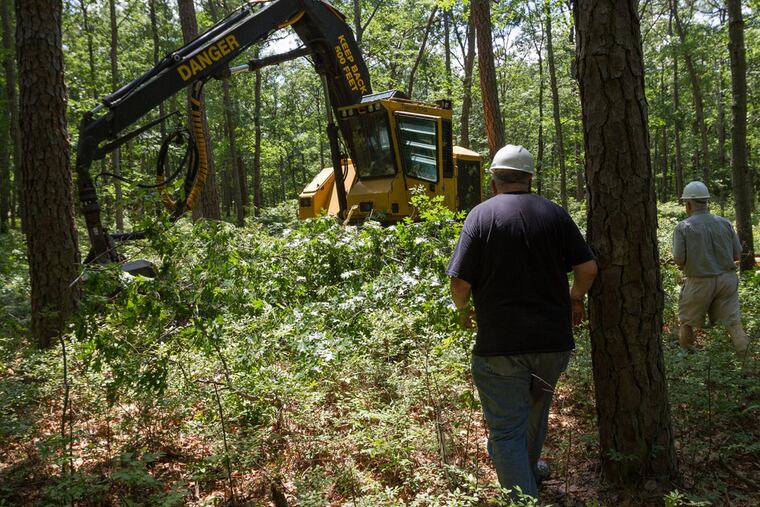
GALLOWAY TOWNSHIP, N.J. - The Pine Barrens surrounding Stockton University were choked with brush and a mix of trees - from white oaks and red maples to Virginia, pitch, and shortleaf pines.
The conditions made for a sickly forest, vulnerable to wildfires and insect infestation, including the destructive southern pine beetle.
But last week - following earlier prescribed burns to clear undergrowth - the woods along Vera King Farris Road began feeling more airy.
The first of hundreds of trees came down, and sunlight again bathed the ground, making it possible for a healthier forest to take root next to the Atlantic County school.
The work, which will spread over a few hundred acres, is part of the Stockton Forest Management Plan, the state's first comprehensive stewardship project on public land in South Jersey, officials said.
"Stockton's forest gives character to our campus and defines who we are," said George Zimmermann, a Stockton professor of environmental studies. He is teaching a summer research course emphasizing forest measurements and allowing students to design experiments related to the university's forest management.
"It's a living laboratory that provides research opportunities that very few students are offered," he said in a statement last week. "It's also a forest that needs our assistance now."
Phase one of the management plan began in March, when about 100 acres of woods underwent controlled burns, officials said. Phase two began on June 30 when Zimmermann climbed into tree-harvesting equipment to cut down the first tree.
The work will be continued by Colin McLaughlin of Advanced Forestry Solutions, based in Pittsgrove, who will thin the forest over the next several weeks into August.
McLaughlin must carefully navigate heavy harvesting machinery around the trees marked with bright pink ribbons labeled "Do Not Cut." The healthiest trees will not be removed.
The downed oaks will become firewood and the pines will be transported to Glatfelter Paper Mill in Spring Grove, Pa., where they will be processed into pulp and converted to high quality paper, university officials said.
The thinning will be followed next winter by more prescribed burns, said Bob Williams, owner of Pine Creek Forestry in Laurel Springs. He is a certified forester with 40 years of experience who was hired by Stockton as a consultant to design the management plan.
"We're trying to create conditions to allow another generation of trees to begin," Williams said in an interview. "The shortleaf pine is a species that has, in some ways, been suppressed by bad logging practices in the past.
"So there is a moratorium on cutting them," he said. "Most of the bigger, nicer trees also will not be cut."
The forest around Stockton will be periodically thinned over the 10-year life of the plan, Williams said.
"It will be more open, with more visual depth," said the forester. "You could walk or hike through it.
"It offers an opportunity for education," he said. "There's nothing more important than helping people understand that we need to manage the forests, and to have this education aspect at a university is really important."
Stockton began taking aggressive steps to manage the forest because of the threat of fires and the southern pine beetle.
In the last several years, the beetle has devastated thousands of acres of the Pinelands, including a resort across the street from the campus, where 3,000 trees were wiped out.
The forest management project affords researchers an opportunity to study insects, Jamie Cromartie, associate professor of entomology at Stockton, said in the statement.
Various trapping methods will be used. One involves the placement of sugar bait on unaffected trees to see how moths and other insects respond to the thinning and whether new species are found.
"We have a lot of specimens and data from many years of collecting in these forests," Cromartie said. "Now we will see whether restoring the forest also increases the abundance of characteristic Pine Barrens insects."
The impact of the tree-thinning will be seen by the end of the summer, Williams said. The management plan covers about 1,400 acres. Trees will be taken down on about 600 acres and hundreds of other acres will have prescribed burns.
The forest "will open up and you'll see trees sprouting leaves because they're getting sun that they didn't get before," he said. "The sun is the key.
"The change happens almost immediately," Williams said. "A healthy forest will be a buffer around Stockton against wildfires and insects."